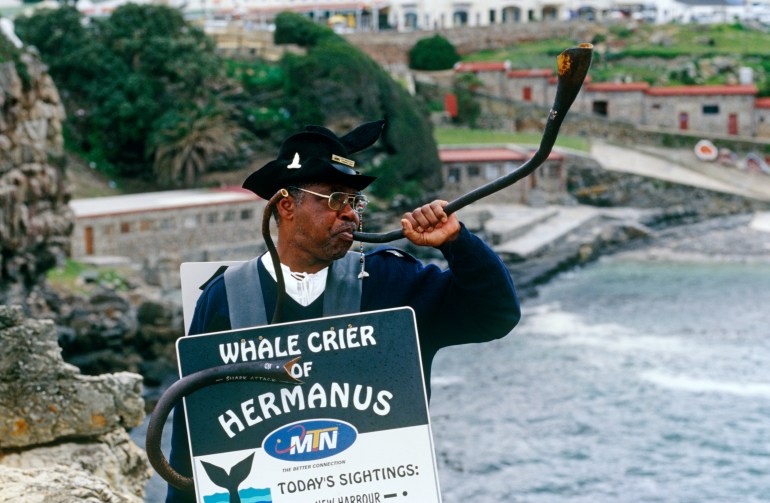I arrive in Hermanus, a picturesque South African coastal village an hour-and-a-half from Cape Town, at about 11am on a sunny October morning. Ignoring the restaurants and art galleries on the main drag and the throngs of tourists watching southern right whales from the cliff path, I drive straight to the harbour to meet Els Vermeulen, the Belgium-born scientist who heads up the whale unit for the University of Pretoria’s Mammal Research Institute.
She is waiting for her colleagues to return from the last whale-tagging sortie of the 2024 season. “I would normally be out on the boat with the team,” says Vermeulen, who is dressed in a bold geometric print dress and a denim jacket. “But I had to drop my kids at school and couldn’t get down here early enough.” The water next to the concrete pier is so clear that I can see a giant orange starfish inching its way along the rocky seabed.
While we wait for the tagging team to arrive, one boatload of whale-watching tourists departs the harbour and another returns. Hermanus, which is an important calving ground for southern right whales, and a good place to spot humpback and Bryde’s whales too, markets itself as the “land-based whale watching capital of the world”. It even has its own “whale crier” who uses a horn fashioned from kelp to announce sightings.

It wasn’t always this way: In the 1910s and 1920s, three separate whaling stations in the area killed hundreds of whales every year. By 1937, more than 80,000 southern right whales had been killed globally and the species teetered on the brink of extinction. In the second half of the 20th century, the focus turned to conservation, and the whales gradually made a comeback.
The southern right whale’s recovery – there are approximately 20,000 individuals today – is one of the world’s great conservation success stories. The two Northern Hemisphere right whale species have not been nearly as lucky, mainly because they live in a much busier ocean. Deaths from ship strikes and getting entangled in fishing gear have thwarted their recovery since the whaling ban, and both species remain Critically Endangered.
And the southern right whale isn’t guaranteed a happy ending, stresses Vermeulen: “The whales are still only at 20 percent of their pre-whaling numbers,” she says. “And now we are seeing all sorts of evidence that they are facing new, indirect threats related to climate change.”
Advertisement
Whales, which cover vast distances and can dive to great depths, are an indicator species for the entire marine ecosystem. And the indicators are not good: Vermeulen’s data shows that whales are much thinner than they used to be, they aren’t breeding as often, and they are changing their main prey.
“That’s them,” says Vermeulen, pointing to a speck on the horizon. About five minutes later, the Balaena – the Whale Unit’s six-metre (19.7-foot) inflatable research vessel – pulls alongside the quay to allow the researchers to disembark. While skipper Chris Wilkinson loads the boat onto its trailer, I chat to Amy Kennedy, a professional whale tagger with 20 years of experience who has flown out from Seattle, Washington to deploy a total of nine tags for the unit.
“It was very tricky today,” says Kennedy. Due to the big swells out at sea, she was only able to deploy one tag. The day before Al Jazeera visited, she managed a record of six tags. Kennedy and her modified line-throwing gun, which is normally used by big ships to throw ropes ashore, are in demand: Just this year she has tagged whales in South Georgia (in Antarctica), the Mediterranean, Tanzania and Mauritius.
“The hardest part is knowing when not to take the shot,” she says, explaining that she has a target area “the size of a desk” to aim at – and that both she and the whale are in constant motion. “I don’t miss any more. But I consider a bad shot a miss. The better your shot, the better the data the whale will transmit.” And the best spot is right behind the fat roll on the back of the whale’s head where the tag can lodge. “The tag only transmits when it’s out of the water, so you want it to be very high on the whale’s body.” The fact that each tag costs $4,000 only adds to the pressure.
Advertisement
“Getting a tag on is a great feeling,” she says, taking a sip on a can of soda. “No matter how many tags you deploy, it never gets old.”

Since 1969: Old data meets new methods
The Whale Unit is the brainchild of Peter Best, who started an annual aerial whale survey for South Africa’s fisheries department way back in 1969. In 1979 Best progressed from simply counting how many whales he saw, to photographing them and using their unique callosity (thickening of the skin) patterns to identify individual whales. When the government decided it no longer wanted to monitor whales, in 1985, Best persuaded the University of Pretoria to open the Whale Unit so he could continue his research.
The photo ID survey, which has been completed every year since 1979, has generated one of the world’s most comprehensive datasets for marine mammals. Vermeulen proudly shows me the boxes upon boxes containing Best’s photographs and handwritten notes. He completed the survey every year for 33 years, before briefly passing the responsibility on to his successor, Ken Findlay, another leading whale expert.

In 2017, Vermeulen arrived from Australia to take over: “It’s the highlight of my year,” she says. “I feel like GI Jane hanging out of a chopper with the most incredible views of these huge animals!”
Advertisement
The data from the aerial survey remains invaluable, especially because it goes back such a long way. But the use of modern technology allows for even deeper insights into these giants of the deep. Satellite tracking data transmitted by tagged whales, using regular SPOT tags, has allowed Vermeulen and her colleagues to figure out that climate change is forcing the whales to change their feeding habits and breeding patterns.
“They are adapting their behaviour and making a plan,” says Vermeulen. “But there’s been a 23 percent reduction in body weight since the 1980s. And they’re only having babies every 4-5 years, instead of every three years.” While their population is still increasing, the rate of increase is slowing – and this is a major cause for concern, says Vermeulen.
“Right whales have a much slower metabolism than species like humpbacks and Bryde’s whales. Everything is slower, they live longer, and they are not good at adapting … Because of all of this, they are much quicker to tell you something is wrong. That’s why we call them sentinels.”
Whales as citizen scientists
In addition to the 26 SPOT tags deployed by Kennedy since 2021, the Whale Unit has also deployed 13 CTD (Conductivity Temperature Depth) tags in 2023 and 2024 – putting it at the forefront of global whale research. While standard SPOT tags measure only location, CTD tags transform whales into citizen scientists by returning data about water salinity – the practical takeaway of conductivity readings – and temperature at different depths as they dive.
While CTD tags have been used widely on smaller animals like seals and turtles, their use on whales – which travel much further and dive much deeper than other creatures – is already proving to be a game-changer.
Until recently, for example, no one knew how deep the animals dove. But we now know that they can reach depths of at least 460 metres (1,509 feet). Whales are also travelling further than we realised: one individual travelled more than 15,000km (9,321 miles) in one year.
![Map shows whale movement patterns of Southern right whales. [Courtesy of the Whale Unit of University of Pretoria’s Mammal Research Institute]](https://www.aljazeera.com/wp-content/uploads/2024/12/image-1734369717.png?w=770&resize=770%2C348)
Interesting facts for sure. However, their value extends far beyond trivia game fodder.
Advertisement
PhD student Matthew Germishuizen – co-supervised by Vermeulen and University of Cape Town oceanographer Marcello Vichi – has just submitted a thesis that used the data gathered by these 23-tonne research assistants to try to determine why the whales are changing their feeding patterns, getting thinner and calving less often.
“It all seems to be related to the significant shift in sea ice conditions in the last 15 years,” he says, explaining that the marginal ice zone (where open ocean meets pack ice) has become much less stable. “This region is a crucial feeding habitat for Antarctic krill, their main prey further south.”
To understand how these changes are affecting whales, scientists are trying to find out more about where they feed, and what environmental conditions generate suitable feeding grounds.
Historically, knowledge of whales’ offshore feeding habitats was obtained from whaling data, where whalers recorded the location of their catches. Since the 1980s and 1990s, scientists have used skin samples to get a vague understanding of what whales are feeding on. “As they forage, their skin develops a signature [the ratio of nitrogen to carbon varies according to their diet] which is used to give a rough estimate of where they’ve been feeding for the previous three months or so,” says Germishuizen. By comparing the isotope signatures from different years, scientists can gain an understanding of how their feeding behaviour is changing.
Over the last 20 years, new technologies are allowing scientists to track whales in almost real-time as they migrate. The most recent development are CTD tags, which have proved especially handy in helping Germishuizen to understand what environmental conditions whales are foraging in. “Every time a whale dives down it collects temperature and salinity data,” he explains. This helped him to describe their foraging grounds based on environmental characteristics.
“Southern right whales have two main prey,” he explains: Antarctic krill, which live very far south in the seasonal sea ice zone, and copepods which live further north in the Antarctic Circumpolar Current (ACC). This current system is one of the fastest and largest in the world, driven by persistent strong winds known as the Roaring Forties. “Declines in sea ice in the areas that are important for Antarctic krill have meant that whales are spending more time feeding in the ACC on copepods,” says Germishuizen.
Advertisement
When feeding on copepods in these mid-latitude zones, Germishuizen found that whales favour ocean fronts, where warmer, saltier waters meet colder fresher waters. “They were targeting a really narrow range of temperature [about 12 degrees Celsius; 54 degrees Fahrenheit] and salinity,” he says. When feeding on krill in Antarctic waters the whales can easily withstand sub-zero water temperatures.
The fronts do not occur uniformly across the ACC and they have shifted southwards about 80km (50 miles) in the last 20 years. “Now we know that these fronts are important,” says Germishuizen. “This is very helpful when projecting conditions into the future using climate change models.”
“The whales are telling us things we didn’t know about the environment,” he adds. “Now we know what the whales are looking for.” And it’s up to scientists, legislators and other role players to use this information to make decisions that increase their chance of surviving the Anthropocene – the epoch since the Industrial Revolution, during which humanity has begun to dramatically impact the natural environment.
![Southern right whales in Hermanus, South Africa. [Courtesy of the Whale Unit of University of Pretoria’s Mammal Research Institute]](https://www.aljazeera.com/wp-content/uploads/2024/12/biologging-whales-SA-research-1734369614.jpg?w=770&resize=770%2C513)
Brave new world
None of the experts Al Jazeera spoke to doubted the magnitude of the task ahead. But they were all equally convinced that technology offers our best chance of making it happen.
As is true for most scientists, funding and capacity are the two biggest challenges facing Vermeulen and her team. Advances in technology have the potential to make both a little easier to deal with.
Advertisement
“The tags are getting better and cheaper every year,” says Vermeulen. “Imagine what we could do with CTD tags that lasted a year. Or if we could afford to deploy twice as many tags every season.”
But tags are not the only way technology can help the whales, says Vermeulen. Scientists have started training AI machine learning tools to identify individual whales on satellite images – and they are already showing a remarkable success rate – even when the images are partially obscured by cloud cover.
Vermeulen is also excited about harnessing the power of AI to create a digital catalogue of all the southern right whales in the world. The last time the Argentina and South Africa catalogues were matched was in the 1990s, says Vermeulen. “It would take a human six months of solid work to sort through everything, But AI could do it in seconds.”
“Having one digital catalogue would be a game-changer,” she adds — anyone who takes a photo of a right whale could upload an image and receive an instant match. “Tourists from Hermanus to Antarctica see loads of whales,” she enthuses. “And they all have cameras and drones.”
And this isn’t just a pipe dream. An app called Happy Whale has already revolutionised scientists’ understanding of humpback whales by using photos uploaded by members of the public to fill in the gaps about the whales’ behaviour. All that’s needed to make one for southern right whales is a new algorithm and about $60,000. “I’ve already raised $30,000,” says Vermeulen. “And I’m hoping to get the rest through a combination of crowdfunding and grants.”
Advertisement
Getting these things right won’t just be a “game-changer” for southern right whales. It will also help scientists to understand the impact climate change is having on entire ecosystems. And it will provide answers about how climate change is playing out differently in different places.
“The whales in New Zealand are doing better than other populations,” says Vermeulen. “Antarctica isn’t affected evenly by climate change. And right whales are helping us to understand why this is and what it looks like.”












More Stories
Q&A: Leader of Myanmar’s shadow government talks civil war strategy in 2025
FBI suspects soldier behind Las Vegas Cybertruck blast suffered from PTSD
Brighton vs Arsenal preview; kickoff time, team news, how to follow, stream